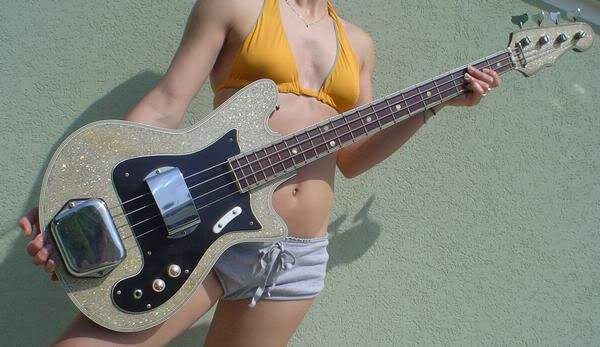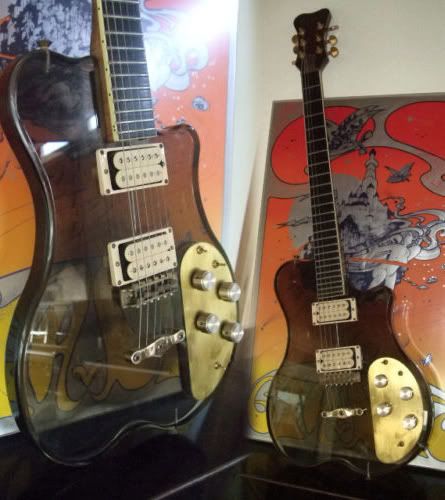
This post will be a little bit fatter than usually, because I wanted to share a little inquiries I made about the Italia Imola 6 guitar, that lead me to rediscover the fabulous Ampeg AEB-1 aka the Horizontal Bass aka the Scroll Bass aka the F-hole Bass, and a couple of its descendants.
There was already a post about this bass last year on Guitarz, with a picture that gives a good idea of what wearing it must feel, with its huge double bass headstock. You can also find a very complete database about it on Johnson's Extremely Strange Musical Instrument Company 's website. Bruce Johnson builds nowadays quite acurate copies of the Scroll Bass that you can see on the small picture on the right.
 The first big pic shows bass amps builder Ampeg's first series of 'horizontal' basses, starting in 1966 - their previous and first instrument was the 1962 Baby Bass, a small body fiber glass/plastic double bass. There are 3 Scroll Bass models, let's keep the Devil Bass (center) for a future post ; the f-hole models are the 1966 AEB-1 (AUB-1 for the fretless version - the very first fretless electric bass), and its 1968 upgraded version the AMB-1/AMUB-1.
The first big pic shows bass amps builder Ampeg's first series of 'horizontal' basses, starting in 1966 - their previous and first instrument was the 1962 Baby Bass, a small body fiber glass/plastic double bass. There are 3 Scroll Bass models, let's keep the Devil Bass (center) for a future post ; the f-hole models are the 1966 AEB-1 (AUB-1 for the fretless version - the very first fretless electric bass), and its 1968 upgraded version the AMB-1/AMUB-1.Of course their most remarkable features are the 2 f-holes cut through the solid body, and the headstocks directly inspired by violon family instruments. It's quite of our time that a retro inspiration would result in such an inovative design!
The AEB-1/AUB-1 was designed to be appeal to upright bass players and featured a weird hidden pickup which was essentially a steel diaphragm over two magnetic coils set into epoxy. This meant that the bass could use gut strings. Notice also the way that the tailpiece extends beyond the body - this was so as to achieve the correct string angle over the hidden pickup.
The AEB-1/AUB-1 was designed to be appeal to upright bass players and featured a weird hidden pickup which was essentially a steel diaphragm over two magnetic coils set into epoxy. This meant that the bass could use gut strings. Notice also the way that the tailpiece extends beyond the body - this was so as to achieve the correct string angle over the hidden pickup.
The later AMB-1/AMUB-1 is a logic adaptation to modern rock sound, with more classical humbucker single pickup for metal strings, smaller head and Fender style tailpiece. You will find a very complete description of all these instruments on Bruce Johnson's website linked above.
Bruce Johnson's contemporary versions AEB-2/AUB-2 intend to be humble improvements of the original model, with the benefit of 40 years on electric lutherie. The few changes are meant to - as Johnson puts it - "bring the Scroll Bass design up to its full potential". That is definitely an instrument I'd love to play!
Bruce Johnson's contemporary versions AEB-2/AUB-2 intend to be humble improvements of the original model, with the benefit of 40 years on electric lutherie. The few changes are meant to - as Johnson puts it - "bring the Scroll Bass design up to its full potential". That is definitely an instrument I'd love to play!

Eastwood's EEB-1 is also a quite faithful reproduction, a noticeable change is the slightly shorter lower f-hole and the pickguard curling around it, and of course you can see that the scroll headstock is gone. I can understand that a modern guitar needs to get rid of vintage oddities - and the replacement headstock has a good design - but you probably loose the feeling of playing a horizontal double bass...
Like Ampeg, Eastwood proposes also a fretless version, the EUB-1.

Now this is the Italia Imola 4 Deluxe in Cherry Sunburst. As you can see, the shape is the same but the two cut-through-body f-holes have been replaced by a more classical one (I actually read contradictory information about this f-hole, here it's called a "faux f-hole", there a "solid body f-hole", also this bass is said to have a "chambered solid body" but without "glued top", so something like vintage Rickenbackers... if someone knows more, it's welcome).
The big contoured pickguard is also there - without the lower f-hole - and the headstock is more classic (and very 60s - it looks like the one of my Musima ES-335 style bass). The pickups are completely different and are closer to a J-bass than to an Ampeg. This bass exists also fretless and/or 5-string.
No matter how much it betrays its Ampeg model, it's a beautiful instrument.

And finally this is the Italia Imola 6 Standard with which the all thing started. For this model Italia didn't try to reproduce a vintage model but extrapolated from their own interpretation of the Ampeg Scroll Bass. The result is a rounded Jaguar shape with a characteristic f-hole partially covered by a large pickguard. The 6 tuners in line headstock is inverted, that seems always to me the logical thing to do - the tuners have easier access and the tension suits better the different string gauges (and it's not only true for metal guitars).
Imola 6 doesn't only stand for 6 strings (as in Imola 4 or 5 for the 4- and 5-string basses) but mostly for the quite original 6 pickups - 3 vintage Teisco style split singlecoils. These pickups and the two 5-way levers allow many combinations - 25 -, some of which are probably quite original and must give this guitar a quite unique sound.
You can find a detailled review on musicradar.com and nothing on italiaguitars.com where the guitar is not even mentioned, though you can find it on their newer (I suppose) JHS website - where the bass models are completely missing... Italia people, please make some maintenance, it's confusing!
Italia is a brand created by Trevor Wilkinson - THE Wilkinson - and intends to combine vintage creativity (isn't it contradictory to look in the past for creativity?) and contemporary technical qualities.
thanks to blogmaster GL Wilson for his expertise about the Scroll Bass.
EDIT. This is a close-up of the scroll headstock of the 1966 Ampeg model - none of the previous pictures give a clear look of it.
EDIT 2. Just found a blog about the original scroll Bass, it's here.
























 The 18-string Thing
The 18-string Thing




















